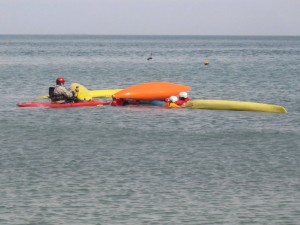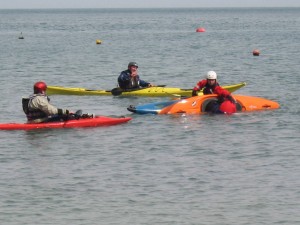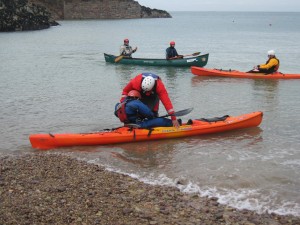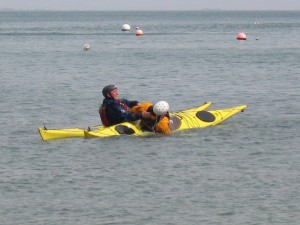BCU Foundation Safety and Rescue Training (FSRT) course
The BCU FSRT is a course that many only consider if aiming for BCU/UKCC Level 1 coach award. This is a shame as it is a great course to really get you focussing on key rescue and safety skills.
Add the requirement to demonstrate kayak rescue skills with a variety of craft and you can be sure to go away with some new ideas.
This is a practical (and wet) course. You need to wear the right kit unless you want to become a real casualty. On our recent course the water was 9 degrees. Those who hired our dry suits were very happy.
Kayak rescue tips
Use similar kayaks
It is surprising how many people paddle with kayaks of very different design and size. It is surprising how often we see a coach paddling their own short short kayak when the rest of the group are using larger craft.
Try emptying a sea kayak while in a small play-boat and you’ll get the message.
Be aware of how diferent kayaks handle
What to you may be a nice following sea to paddle may be a real pig of a sea for another paddler using a different type of kayak.
Have a range of kayak and sit-on-top capsize and rescue techniques
Kayaks and people come in different shapes and sizes. Be prepared to use different methods when dealing with kayak rescues.
Communication
Give clear and concise instructions.
Project your voice. Standing on the harbour wall I could hear some paddlers clearly and others were very hard to hear even when the same distance away.
Signals
Make sure you have agreed what a signal means.
Signals need to be clear
Lead
Take charge and lead.
Try this test. Do a rescue in silence and the repeat with someone taking control. Most find the rescue with leadership is faster.
Check the abilty of the group
Check who has safety kit, are paddlers wearing the right clothing for the activity.
It is surprising how many times paddlers go afloat without anyone checking what safety kit is carried. A quick question can highlight items left in the car.
Is everyone in the group happy with the plan?
Be prepared to modify plans. Be honest-tell others if you are not happy with the way the trip is progressing.
Carry a tow line
An essential safety aid.
Know how to use a tow line.
Practice your kayak capsize and rescue skills
A capsize is not the time to start trying to remember how to do a rescue, set up a tow or get a person back on board.
Practice in a range of conditions.
Add air bags to kayaks
Even sea kayaks with bulkheads should have air bags in case of hatch problems.
Short kayaks need air bags- especially if you are expecting a lot of capsizes. This reduces the risk of back injury and makes rescues easier. The pillar buoyancy on some designs is not enough.
Consider the build of paddlers in the group
You may find emptying or re-entering a kayak easy but others may not. Develop a range of techniques and test them in advance. A kayak rescue method on YouTube may look great but the reality may be very different for you and your group. This is especially the case when lookign at the use of slings and strops to help paddlers re-enter the kayak.
I’ll be running kayak safety courses in Jersey over the Summer. Dry suits can be supplied on request.
A short video of the training. Some of the demonstrations may not be “text book” examples. Remember this is a group of 2 star paddlers and a coach developing skills.




